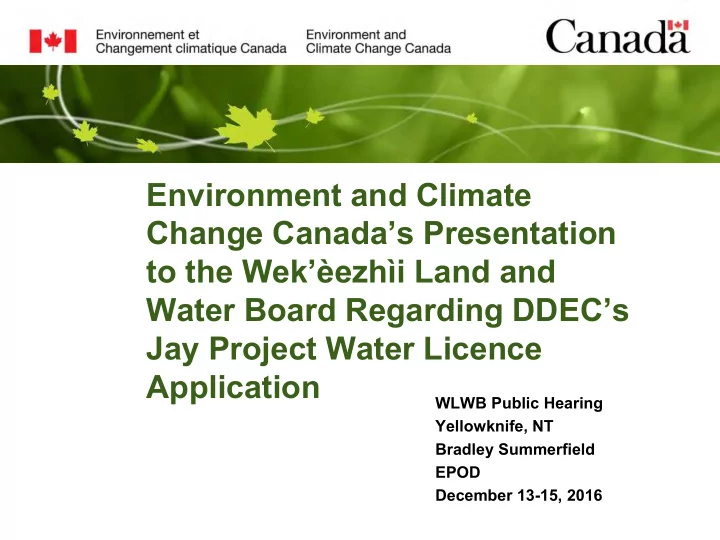

Environment and Climate Change Canada’s Presentation to the Wek’èezhìi Land and Water Board Regarding DDEC’s Jay Project Water Licence Application WLWB Public Hearing Yellowknife, NT Bradley Summerfield EPOD December 13-15, 2016
ECCC’s Mandate • Preserve and enhance the quality of the natural environment • Conserve Canada’s renewable resources • Conserve and protect Canada’s water resources • Forecast daily weather conditions and warnings • Enforce rules relating to boundary waters • Coordinate environmental policies and programs for the federal government Page 2 – 30 novembre 2016
How ECCC Fulfills its Mandate Relevant acts and regulations: • Department of the Environment Act • Canadian Environmental Protection Act • Fisheries Act – Pollution prevention provisions • Migratory Birds Convention Act • Species at Risk Act Page 3 – 30 novembre 2016
Recommendation 1 – Effluent Quality ECCC Recommends: • Chloride concentrations should be monitored in the lake and the proponent should ensure that chloride concentrations do not violate section 36(3) of the Fisheries Act . • The proponent should also ensure that Total Dissolved Solids concentrations do not violate section 36(3) of the Fisheries Act. Page 4 – 30 novembre 2016
Recommendation 2 – Dike Construction TSS Management and Monitoring ECCC Recommends: • Calculation of the moving 30 day average should not include baseline data for the first 30 days, i.e. it would be a simple average for this period. • Monitoring results for dike construction should be reported in addition to the Surveillance Network Program data and could be included in the Annual Report as well (as an example, see the Meadowbank Gold Project 2010 Annual Report Appendix A4 Report: 2010 Causeway and Dike Construction Monitoring Report). • Real-time turbidity measurements be taken using automated loggers, to supplement the daily turbidity profiles, including in winter. Most appropriate sites should be determined taking turbidity barrier configuration and bathymetry into account . Page 5 – 30 novembre 2016
Recommendation 3 – Use of Sub Lethal Toxicity Testing ECCC recommends: • Chronic toxicity testing be done on whole effluent from end-of-pipe in order to eliminate effects on test results from testing in the receiving environment. Tests could include the Ceriodaphni a test, algal test, fish early life stages, and Lemna . Page 6 – 30 novembre 2016
Recommendation 4 – Seepage Quality ECCC Recommends: • Seepage from the Jay Waste Rock Storage Area be closely monitored for occurrence. • If observed, seepage should be characterized for chemistry and flow volumes (not just during the twice a year seepage survey program). • Contingencies should be identified for diverting and retaining any poor quality flows in order to prevent the seepage from entering Lac du Sauvage. Page 7 – 30 novembre 2016
Recommendation 5 – Aquatic Effects Monitoring Program (AEMP) ECCC Recommends: • An AEMP working group be formed, or a workshop format meeting be used to discuss and address details of the proposed monitoring program. • Monitoring during the operations phase should be linked to and build comprehensively on the baseline information and construction phase. Page 8 – 30 novembre 2016
Thank-you Page 9 – 30 novembre 2016
Recommend
More recommend